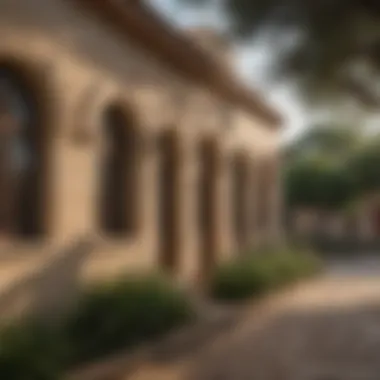Exploring the Diverse Neighborhoods of San Antonio


Intro
San Antonio, Texas, offers a vivid tapestry of neighborhoods that reflect its rich history and multicultural essence. Each area possesses its unique traits, making the city a fascinating destination for residents and visitors alike. Exploring the various regions provides insights into architectural styles, historical significance, and community dynamics. This exploration is tailored for real estate enthusiasts, travel lovers, and interior design aficionados eager to engage with San Antonio's diverse appeal.
Feature Spotlight
Exceptional Architectural Designs
San Antonio showcases a variety of architectural styles, from Spanish Colonial to contemporary structures. The historic downtown area features notable edifices such as the majestic San Fernando Cathedral and the intricate tile work of the Spanish Governor's Palace. These buildings not only represent specific time periods but also reflect the cultural influences that shaped the city. The neighborhoods of Alamo Heights and Terrell Hills host stunning mid-century modern homes and elegant traditional designs that appeal to those interested in home design.
Unique Decor Elements
The decor found throughout San Antonio adds layers of character to its neighborhoods. Vibrant murals in places like the Deco District tell stories of the community's heritage. Furthermore, the unique details, such as wrought iron balconies and colorful stucco facades, enhance the charm of homes. Designers can find inspiration in the eclectic mix of styles and colors, which embody both creativity and historical context.
Location Highlights
Must-Visit Neighborhoods
- The Pearl
Once a brewery, The Pearl is now a culinary hotspot featuring a variety of restaurants, shops, and markets. The architecture remains faithful to its industrial roots, blending modern elements with historical structures. - La Villita
This historic neighborhood offers a glimpse into San Antonio's past. The cobblestone streets and artisan shops reflect the city's artistic spirit, making it an essential stop for visitors. - Southtown
Known for its vibrant arts scene, Southtown offers galleries, unique shops, and an exciting nightlife. The architectural blend of historic homes and trendy lofts attracts a diverse crowd.
Cultural and Historical Significance
San Antonio is rich in cultural and historical milestones. The Alamo stands as a symbol of bravery and resilience, drawing attention from tourists worldwide. Additionally, the annual Fiesta San Antonio celebrates the city's history and diversity through parades and festivities.
"San Antonio is a city that embraces its past while also looking toward the future. Each neighborhood tells a story, contributing richly to the city's identity."
Understanding these aspects allows potential homebuyers to grasp what makes each neighborhood special.
Ending
Exploring San Antonio, Texas, reveals a city filled with character and depth. Each district contributes uniquely to the urban landscape, combining rich history with modern living. For those considering a move to this vibrant city, knowing the neighborhoods helps inform decisions and appreciate the cultural richness that San Antonio offers.
Prelude to San Antonio
San Antonio, Texas, is a city steeped in rich history and cultural diversity. It is vital to understand the foundational role this city plays in the tapestry of American cities. This section introduces key elements that shape San Antonio's identity, making it a significant point of interest for various audiences, including real estate enthusiasts, travel lovers, and interior design aficionados.
San Antonio is not merely a location; it is an amalgamation of unique neighborhoods and districts, each offering distinct characteristics. The city's unique history can be traced back to its colonial roots, reflected in the architecture and urban layout. A deep understanding of these elements allows potential homebuyers and designers to appreciate the nuances that different areas contribute to city life.
One aspect that stands out in San Antonio is its vibrant cultural scene. Festivals, artwork, and community events provide a glimpse into the local lifestyle, which is intertwined with its historical background. Such insights can inspire design choices and lifestyle considerations for those looking to settle in or explore the city.
In terms of real estate, knowing San Antonio's various neighborhoods is essential. Each area presents unique opportunities and challenges that prospective buyers should consider. This introductory section helps set the stage for a deeper examination of specific regions later in the article.
"To appreciate San Antonio is to understand its layers; each neighborhood tells a different story."
In summary, this introduction provides a crucial framework and context as we delve into the historical overview, major areas, and cultural significance of San Antonio. Through this exploration, readers will gain a nuanced appreciation for the city's charm and complexity.
Historical Overview of San Antonio
The historical overview of San Antonio is crucial for understanding its identity. This section details how the area's past influences its present and future. Knowing the historical context helps in appreciating the culture, architecture, and community dynamics of San Antonio today. It also provides insights for real estate enthusiasts and travelers looking to connect with the city's rich narrative.
Colonial Foundations
San Antonio's origins can be traced back to the Spanish colonial period in the early 18th century. Founded in 1718, it became a significant military and religious hub. The establishment of the Alamo in 1836 marked a turning point. This mission became a symbol of Texas independence. The Spanish missions, including San José and San Juan, were essential for spreading Christianity and serving as centers for agricultural development. These early foundations laid a framework for population growth and cultural diversity.
The influence of Spanish architecture is still evident today. Visitors can explore the historic sites that showcase this rich heritage, which includes the intricate designs and layouts characteristic of Spanish colonial buildings. The preservation of these sites is vital for keeping the history alive.
Growth Through the 19th Century
As Texas gained its independence, San Antonio continued to grow. The city became a major trade route, linking Mexico and the United States. This position attracted settlers and businesses, which in turn stimulated economic development. By the late 1800s, San Antonio was recognized as a notable city in Texas with a thriving population.
Advancements in transportation, such as the introduction of the railroad, helped in this expansion. Moreover, the influx of diverse cultures, including Germans and Czechs, shaped the local customs and cuisine. Festivals and celebrations from various heritages contributed to the vibrant community atmosphere. Understanding this growth prepares one to appreciate the complex social fabric of the city.
Recent Development Trends
In recent years, San Antonio has seen significant transformation. Urban renewal projects have revitalized neighborhoods while respecting their historical significance. Millennial buyers are drawn to downtown living, encouraged by nearby attractions and amenities.
The real estate market has experienced a surge, with new developments focusing on sustainability and modern lifestyles. Areas like Southtown and Stone Oak are prime examples of how New Urbanism principles are applied. Mixed-use developments are designed to integrate residential, commercial, and recreational spaces. This trend reflects a broader priority for community-oriented living that emphasizes convenience and quality of life.


Maintaining a balance between progress and preservation is critical. Elected officials and city planners must consider how to accommodate growth while cherishing the heritage that defines San Antonio.
"San Antonio serves as a case study on how history and modernization can coexist."
Overall, the historical overview of San Antonio reveals much about its identity. From its colonial foundations to its growth and recent trends, each period informs the next. This continuity offers a framework for individuals exploring both the past and future of this vibrant city.
Major Areas in San Antonio
San Antonio is not just known for its historical significance but also for a variety of vibrant neighborhoods that contribute to the city’s unique identity. Each area offers distinct characteristics, cultural elements, and lifestyle options. Understanding these major areas is vital for anyone interested in real estate, tourism, or the architectural nuances of the city. By exploring these regions, readers can grasp the diverse fabric that makes up San Antonio.
Downtown San Antonio
Downtown San Antonio is often regarded as the economic heartbeat of the city.
Economic Hub
Downtown serves as the center for commerce and business in San Antonio. This area is home to numerous corporate offices and startups, making it a prime location for professionals. The accessibility to major transportation and infrastructure significantly enhances its appeal. Moreover, the variety of retail shops, restaurants, and entertainment venues draws both residents and visitors alike.
One significant aspect of the Downtown economic hub is the San Antonio River Walk. This unique waterway features scenic dining, shopping, and leisure opportunities, bringing tourism to its peak. However, high demand can lead to elevated living costs, which may deter some potential residents.
Architectural Highlights
The architectural landscape of Downtown San Antonio reflects its rich history and modern growth. Various styles coexist, from historic buildings like the San Fernando Cathedral to contemporary skyscrapers.
This diversity in architecture not only enriches the skyline but also provides a sense of place. The area's unique feature is its well-preserved historical buildings, which juxtapose against modern construction. This blend celebrates both the old and new, although the challenge arises in maintaining the authentic character amid ongoing development.
Alamo Heights
Alamo Heights stands out for its residential appeal, characterized by a mix of established homes and new constructions.
Residential Appeal
Alamo Heights is known for its quaint charm and upscale living. The tree-lined streets are inviting, housing various architectural styles that attract families and professionals. The area is highly sought after, thanks to its excellent schools and proximity to Downtown.
A unique feature is the sense of community found in Alamo Heights. Local parks and recreational facilities promote outdoor activities, contributing to a family-friendly atmosphere. However, real estate prices are generally higher compared to other neighborhoods, which can be a barrier for some homebuyers.
Cultural Institutions
Cultural institutions play a critical role in Alamo Heights, sustaining its artistic and educational environment. The area boasts theaters, art galleries, and museums that engage residents and visitors alike.
For example, the McNay Art Museum is an essential landmark, illustrating the neighborhood's commitment to the arts. This not only enriches the community but also attracts those interested in culture and history. The ongoing cultural events provide opportunities for residents to participate actively, although the challenge remains in balancing modernization with traditional preservation.
Stone Oak
Stone Oak is recognized for its family-friendly environment conducive to raising children.
Family-Friendly Environment
Stone Oak's residential developments are primarily tailored for families, offering various amenities suited for children and parents. Parks, recreational centers, and quality schools make it an attractive area for young families seeking a supportive community.
This neighborhood's unique feature is its planned communities, which often come with safety measures and family-oriented activities. However, with rapid growth comes the challenge of congestion and longer commutes, which potential residents should consider.
Modern Amenities
Stone Oak also encompasses modern amenities that enhance residents' quality of life. Shopping centers, restaurants, and medical facilities are conveniently located within close proximity.
This aspect promotes a self-sufficient lifestyle where individuals do not have to travel far for daily needs. However, as the area grows, some residents may find that the increase in population leads to increased traffic and competition for services.
The Dominion
The Dominion is synonymous with luxury living, representing one of San Antonio's most affluent communities.
Luxury Living
The Dominion features gated communities and upscale homes, making it a prime choice for those seeking a high-end lifestyle. The beautifully manicured landscapes give the area an exclusive appeal, attracting executives and affluent individuals.
One significant characteristic is the emphasis on privacy and security, enhancing the overall living experience. However, affordability can become a pressing concern, as the high-end market can exclude a broader audience.
Exclusive Features


Beyond exclusive homes, The Dominion offers remarkable amenities such as prestigious golf courses and luxury spas. The area hosts private clubs and high-end shopping, catering to a lifestyle of leisure and comfort.
This unique feature adds further value for residents seeking an elite community experience. Yet, the high cost of living may limit accessibility for families not in the higher income bracket.
Southtown
Southtown is celebrated for its vibrant artistic community, reflecting the creative spirit of San Antonio.
Artistic Community
Southtown is an eclectic mix of artists, musicians, and creative professionals. It hosts galleries and performance spaces that capture the area’s bohemian essence. The variety of artistic expressions found here contributes significantly to San Antonio's cultural scene.
The unique feature of Southtown is the annual Art Walk, where local artists showcase their work, engaging the community. However, the transient nature of the artistic community can lead to shifts in culture and only sporadic events throughout the year.
Culinary Scene
In addition to art, Southtown boasts a thriving culinary scene that showcases diverse cuisines. Restaurants, cafes, and food trucks serve something for every palate, drawing food lovers from all over the city.
With an emphasis on local ingredients and innovative dishes, the culinary options are a major highlight. However, the popularity can result in wait times and a bustling atmosphere, which may not suit everyone.
Cultural Significance of San Antonio Areas
Understanding the cultural significance of distinct areas within San Antonio allows a deeper appreciation for the identity of this city. Each neighborhood offers a tapestry of history, traditions, and vibrant community life. The architectural styles reflect the diverse heritage present in San Antonio, shedding light on the interactions of various cultures throughout its development. Identifying these elements enhances the overall narrative of San Antonio as not just a location, but as a living story.
Historic Landmarks
The Alamo
The Alamo stands as a pillar of Texas history. This mission site is known for its role in the Texas Revolution, particularly the battle that took place in 1836. Its preservation allows visitors to immerse in the events that shaped the state’s identity. The Alamo draws significant tourism, serving as an educational opportunity for locals and visitors alike. The unique aspect of The Alamo is its ability to tell a complex story of sacrifice, freedom, and the struggle for independence.
A journey to San Antonio is incomplete without exploring The Alamo's storied grounds.
The Alamo's location in the heart of downtown facilitates easy access for tourists and residents. While it represents a momentous historical site, it also poses challenges with crowd management, especially during peak seasons. The balance between tourism and preservation remains crucial as the site evolves.
Spanish Missions
The Spanish Missions are another testament to the cultural heritage of San Antonio. These missions were established in the 18th century and serve as tangible links to the Spanish colonial era. They highlight the spread of Catholicism and the establishment of community centers among the indigenous populations. Today, these missions are recognized as UNESCO World Heritage Sites, underscoring their global importance.
One key characteristic of the Spanish Missions is their architectural style, which incorporates elements of Spanish colonial design. This aspect enhances the visual landscape of San Antonio, offering a historical perspective within a modern urban setting.
Navigating the missions allows individuals to appreciate the significance of cooperation between different cultures. However, challenges arise in maintaining the integrity of these sites in the face of urban expansion and modernization efforts.
Festivals and Events
Fiesta San Antonio
Fiesta San Antonio is a celebration that honors the city's diverse heritage. It began as a simple parade in 1891 and has since evolved into a ten-day event filled with culture, food, and music. This festival draws thousands of visitors, showcasing local art and traditions, making it a cornerstone of San Antonio's cultural scene. The vibrant atmosphere highlights the unity of communities within the city.
The unique aspect of Fiesta San Antonio is its inclusivity, allowing various cultural groups to share their customs and traditions. This serves both as a celebration of diversity and a platform for local businesses. While the festival fosters community spirit, it also requires careful planning to manage crowds and ensure safety for participants.
Diwali Festival
The Diwali Festival in San Antonio represents the cultural significance of the local Hindu community. Celebrated annually, this festival of lights symbolizes the victory of light over darkness and good over evil. The event features colorful displays, traditional dance, and delicious Indian cuisine. It creates a space for cultural exchange, enriching the overall fabric of San Antonio’s community.
A key characteristic of the Diwali Festival is its emphasis on community participation, where people from various backgrounds come together. This festival promotes understanding and sharing of cultural practices, contributing to a cohesive society. However, relying on donations and community support for the event's success presents ongoing challenges.
In summary, the cultural significance of landmarks like The Alamo and events such as Fiesta San Antonio and the Diwali Festival illustrates the rich diversity and history of San Antonio. These elements together create an environment that encourages knowledge, respect, and appreciation for the intricate cultural landscape that defines this unique city.
Architectural Styles Across San Antonio
Understanding architectural styles in San Antonio provides insight into the city's cultural and historical evolution. Each style contributes to the city’s visual identity and reflects the influences of diverse communities. This section explores three significant architectural styles: Spanish Revival, Mid-Century Modern, and Contemporary Residences. Each style brings unique characteristics and contributes to the overall appeal of San Antonio.
Spanish Revival
Spanish Revival architecture is prominent in San Antonio, reflecting the city's colonial history and influences from Spain. This style is characterized by its tile roofs, stucco walls, and ornate ironwork. The aesthetic often includes arches, exposed wooden beams, and decorative ceramic tiles. Homes built in this style often resemble those found in Mediterranean regions and embody a rich sense of heritage.
Benefits of this style include:
- Timeless Appeal: Spanish Revival homes carry a classic charm, making them desirable to many homebuyers.
- Low Maintenance: The stucco exteriors resist damage from extreme weather, reducing upkeep concerns.
- Artistic Detail: Features such as handcrafted tile and wooden doors enhance visual interest.


Mid-Century Modern
Mid-Century Modern architecture emerged in the mid-20th century and continues to be appreciated for its functionality and aesthetic simplicity. This style is defined by clean lines, large windows, and an integration with the surrounding environment. The emphasis is on open spaces and minimalistic design, appealing to those who appreciate straightforward and functional living.
Some key aspects include:
- Integration with Nature: Homes often have large glass windows and sliding doors, providing natural light and views of outdoor spaces.
- Sustainability: Many Mid-Century Modern designs prioritize energy efficiency.
- Versatile Spaces: Open floor plans make these homes suitable for modern lifestyles, accommodating both entertaining and relaxing areas.
Contemporary Residences
Contemporary architecture in San Antonio showcases current design trends, reflecting the city’s ongoing growth and modernization. These homes often feature bold shapes, innovative materials, and eco-friendly designs. Contemporary residences prioritize sustainability, often incorporating energy-efficient technologies and materials.
Distinct characteristics include:
- Innovative Designs: Architects frequently use new materials such as steel and reinforced glass for striking aesthetics.
- Flexibility: Contemporary spaces are adaptable and can cater to various lifestyles.
- Community Connection: Many designs focus on connectivity with the neighborhood, promoting a sense of belonging.
The evolution of architectural styles in San Antonio is a testament to its dynamic culture, blending history with modernity.
Real Estate Trends in San Antonio
Understanding real estate trends in San Antonio is essential for anyone interested in the city's housing market. These trends reflect not only the economic conditions but also the way people live and work in this vibrant city. As San Antonio grow, the dynamics of the real estate market evolve, influencing buyers, investors, and builders alike.
Market Dynamics
Market dynamics play a crucial role in shaping the real estate landscape. In San Antonio, these dynamics include fluctuations in home prices and changes in inventory levels. Both factors are indicators of the market’s health and help potential buyers and sellers understand the current conditions.
Price Trends
Price trends refer to the movements of residential property values. In recent years, San Antonio has experienced a steady appreciation in prices, driven by increasing demand and limited supply. This trend makes it attractive for potential buyers and investors. The increasing prices suggest a robust market, although it also poses challenges for first-time buyers.
Some factors to consider regarding price trends include:
- Location: Properties in upscale neighborhoods like Alamo Heights often see higher price appreciation compared to others.
- Economic Growth: Job growth and population influx contribute to rising home values.
- Market Competition: A competitive market can drive up prices, making quick decisions essential for buyers.
However, the rising prices may deter some buyers. It is important to assess both opportunities and risks when navigating pricing aspects in this market.
Inventory Analysis
Inventory analysis examines the number of available homes on the market. In San Antonio, inventory levels have fluctuated recently, impacting buyer options. An analysis of inventory helps identify whether the market favors buyers or sellers.
Key points about inventory include:
- Availability: A limited number of listings often leads to increased buyer competition, which can drive home prices higher.
- Market Types: Different neighborhoods can show varying levels of inventory, which influences buyer choices and market strategies.
- Trends: Real estate professionals monitor inventory shifts closely to guide clients effectively.
Limited inventory can be both a challenge and an opportunity. Buyers need to be strategic and possibly act quickly when they find the right property.
Emerging Neighborhoods
Emerging neighborhoods in San Antonio offer potential opportunities for homebuyers and investors. Areas such as the East Side and parts of the Northwest Side are gaining popularity due to their affordability and attractiveness for young professionals.
These neighborhoods often feature a blend of historic charm and modern amenities, making them appealing for a diverse range of residents. Identification of these areas can help buyers and investors capitalize on potential growth before prices escalate.
In summary, staying informed about real estate trends is imperative for navigating the complex housing market in San Antonio. Understanding market dynamics, including price trends and inventory levels, provides a foundation for making informed decisions. Likewise, exploring emerging neighborhoods opens avenues for growth and investment in this thriving city.
Closure: The Future of San Antonio Areas
As the city of San Antonio continues to grow, understanding the future of its diverse neighborhoods becomes increasingly important. This exploration of various areas offers insights into how they will evolve, shaping both individual and communal experiences.
Importance of Forward Thinking
Urban development in San Antonio is influenced by several factors including population growth, economic changes, and cultural trends. Acknowledging these influences helps residents, developers, and investors in making informed decisions that can enhance community life.
Potential for Growth
San Antonio is experiencing a boom, particularly in areas such as Downtown and Stone Oak. Both neighborhoods show signs of increasing interest from homebuyers and businesses alike. The real estate market is adapting to the demands of modern living, with more mixed-use properties and sustainable designs on the horizon. Local government initiatives are also pushing for infrastructural developments to support this growth.
Benefits of Diversity in Development
With a mix of historic preservation and modern innovations, the city's approach allows for diverse architectural styles to flourish. This can attract a variety of residents, each contributing uniquely to the local culture. Residential and commercial properties cater to different demographics, ensuring a rich blend of experiences. Alamo Heights stands out for its residential appeal while Southtown is known for its arts community.
Considerations for the Future
As new projects arise, it is critical to balance growth with maintaining the unique character of each area. Community involvement in planning processes becomes essential. Residents should have a voice in how their neighborhoods develop, ensuring that changes reflect collective desires rather than solely economic interests.
"San Antonio's neighborhoods represent a mosaic of culture, history, and innovation. The future depends on how well we preserve these elements amid growth."







